Top 10 Famous Folk Dances of Kerala, Know about their Origins & Performances
By Pinkey Sharma |
Date 20-08-2024

Table of Contents
- Dance Culture of Kerala:
- List of Top 10 Famous Folk Dances of kerala:
- 1. Kathakali:-
- 2. Mohiniyattam:-
- 3. Theyyam, a Divine Ritual Dance:-
- 4. Thiruvathirakali:- The Festive Circle Dance
- 5. The Stick Dance, or Kolkali:-
- 6. Ottamthullal, The Comic Satire Dance:-
- 7. Kalaripayattu:-
- 8. Padayani:- The Vibrant Ritual Dance for Goddess Bhadrakali
- 9. Oppana:- The Joyful Wedding Dance
- 10. Margamkali:- The Spiritual Dance of Christian Heritage
- Wrapping Up:-
- Frequently Asked Questions (FAQs):-
Admissions Open for
Kerala is famous for its beautiful scenery, calm backwaters, and rich cultural history. It is often called "God's Own Country." Kerala's folk dances are one of the most interesting parts of its culture. They show the state's traditions, faith, and sense of community. Every kind of dance in Kerala tells a different story about its past, myths, and everyday life. These acts are more than just fun they are living traditions that are still going strong today.
In this blog we will talk about some of the most well known folk dances in Kerala. We will also talk about where these dances came from, how they look like, and what they exactly mean.
Dance Culture of Kerala:
Kerala's rich legacy is brought to life through its dance culture, which is like a vibrant tapestry woven with customs, festivals, and stories. Consider the dance named Kathakali, in which dancers impersonate gods and heroes by painting their faces and donning ornate costumes, using dramatic facial expressions and movements to tell epic tales. Next is the elegant dance known as Mohiniyattam, which is done by women and features flowing motions that express beauty, love, and devotion.
Theyyam is an enthralling ritual dance that bestows blessings on the society by transforming performers into divine entities. Not to be overlooked is Kalaripayattu, an age-old martial art that combines dancing and fighting techniques to display power and expertise. Kerala's dances are more than just shows; they are living traditions that bring people together, celebrate life, and preserve the state's history via rhythm and movement, whether it be the exuberant Padayani to thank the gods or the happy Oppana during weddings. A little of Kerala's soul can be found in every dance.
List of Top 10 Famous Folk Dances of kerala:
|
Dances |
Brief |
|
Kathakali |
A classical dance drama that tells stories from Hindu epics, known for its detailed costumes and strong facial expressions. |
|
Mohiniyattam |
A gentle dance performed by women, known for smooth, flowing movements, often expressing stories of love and worship. |
|
Theyyam |
A dance offered to gods, featuring detailed costumes and face paint, believed to transform the dancer into a divine messenger. |
|
Thiruvathirakali |
A group dance for women celebrated during festivals like Onam and Thiruvathira, symbolizing happy marriage and feminine beauty. |
|
Kolkali |
A folk dance involving wooden sticks, linked to the fighting traditions and farming history of northern Kerala. |
|
Ottamthullal |
A humorous dance form created by poet Kunchan Nambiar, using comedy to talk about social issues, often referred to as the common person's version of a more elite dance. |
|
Kalaripayattu |
One of the oldest fighting styles that combines martial arts with dance-like movements, often called the origin of all martial arts. |
|
Padayani |
A ritual dance with large, vivid masks and loud drumming, honoring Goddess Bhadrakali, showing stories from mythology. |
|
Oppana |
A happy dance performed during Muslim weddings, where a group of women dance and sing around the bride to celebrate. |
|
Margamkali |
A dance performed by the Syrian Christian community, representing the 12 apostles of Jesus, often performed at Christian weddings and celebrations. |
Is your kid a dance enthusiast?
Discover more and ignite their passion on our Orchid's Dance Activity Page!
1. Kathakali:-
Kathakali (in malayalam: കഥകളി) derives its name from the Malayalam language, meaning 'story play'. It is a classical dance-drama with a history spanning 500 years, renowned for bringing ancient epics to life through vibrant performances, Primarily performed by men, this dance form is distinguished by its elaborate costumes, intricate makeup, and the portrayal of deep emotional expressions through facial movements.
Elaborate Kathakali dance performance
Origin and history:-
Kathakali has its roots in old temple rituals and classical Sanskrit dramas. It was first performed in the 17th century. Scenes from Hindu epics like the Ramayana, Mahabharata, and Puranas are often used in the stories.
How to Perform:-
Kathak dancers tell stories with precise body movements, exaggerated face expressions, and detailed hand gestures called mudras. Each performance starts with Chutti, which is the application of bright makeup to the face to show what the character is like. Live singers and instruments like the chenda and maddalam play in the background, and dancers use dramatic facial expressions to fascinate the crowd.
Fun fact:-
-
Kathakali makeup is very complicated and can take up to three hours to finish. Each color represents a different mood or personality trait.
2. Mohiniyattam:-
Mohiniyattam (in malayalam: മോഹിനിയാട്ടം), meaning "dance of the enchantress," is a graceful and feminine classical dance form performed entirely by women. Love and loyalty are themes that run through it.
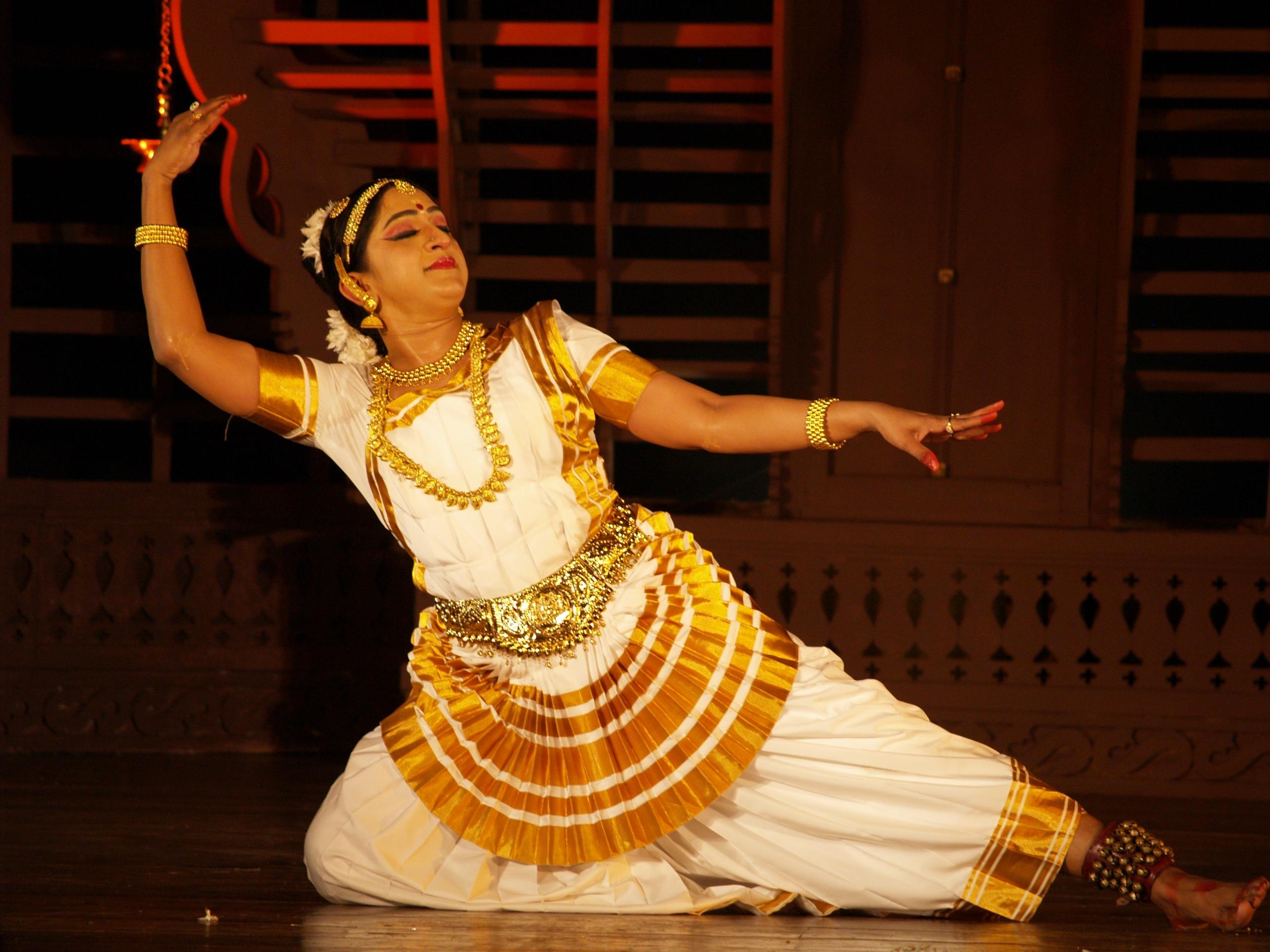
Graceful Mohiniyattam dancer performing
Origin and History:-
This ancient dance form dates back over 2,000 years and is linked to the mythological tales of Lord Vishnu, who took the form of an enchantress (Mohini) to protect the universe.
How to Perform:-
Women who perform wear traditional white and gold sarees and put jasmine flowers in their hair. Carnatic music goes well with the movements, which are graceful, circular, and slow. Traditional instruments like the mridangam and veena are played along with the dance, making the atmosphere calm and beautiful.
Fun fact:-
-
Mohiniyattam is often thought of as Kathakali's "feminine counterpart" because it emphasizes grace and soft expressions.
3. Theyyam, a Divine Ritual Dance:-
Theyyam (in malayalam: തെയ്യം), a ritualistic dance, is an important aspect of Kerala's temple culture, particularly in the northern Malabar region. It is done as an offering to the Gods.
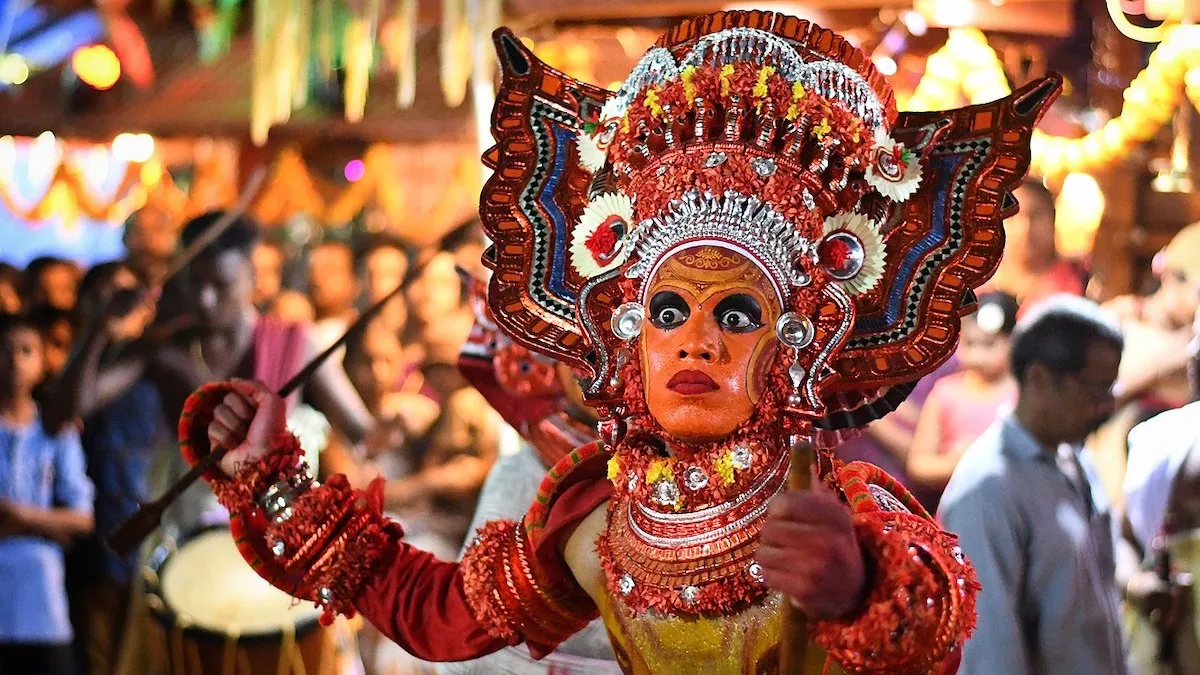
Vibrant Theyyam ritual dance
Origin and History:-
Theyyam, originating from Dravidian traditions, has a history of nearly 1,500 years. It is thought that throughout the performance, the dancer transforms into a divine channel, benefitting the worshippers.
How to Perform:-
Performers wear extravagant costumes, high headgear and detailed face paints. Theyyam is a dramatic retelling of holy stories accompanied by percussion instruments. The ritual frequently begins with the chanting of Thottam Pattu, sacred hymns that tell the deity's tale.
Fun fact:-
-
Women only do Devakoothu Theyyam, while men perform all other kinds.
4. Thiruvathirakali:- The Festive Circle Dance
Thiruvathirakali (in malayalam: തിരുവാതിരകളി), or Kaikottikali, is a traditional group dance performed by ladies at holidays such as Onam and Thiruvathira. It represents marital peace and feminine charm.
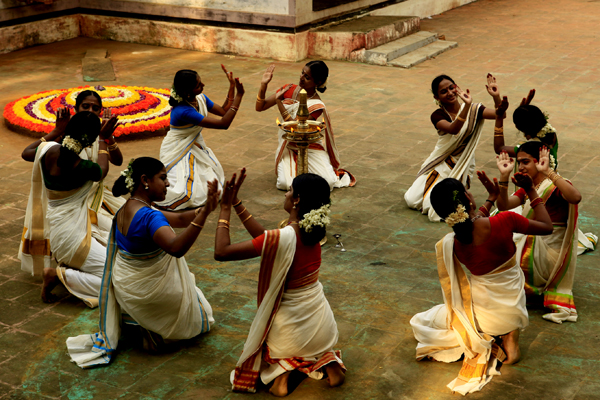
Women performing Thiruvathirakali dance
Origin and History:-
The origin and history of this dance may be traced back to Kerala's agrarian culture, when it was performed to celebrate fertility and success. It is related with worshipping Lord Shiva and Goddess Parvati.
How to Perform:-
To perform, dancers create a circle and move rhythmically, clapping their hands and chanting Thiruvathira Pattu. The movements are basic but graceful, representing joy and unity.
Fun fact:-
-
Thiruvathirakali is celebrated in the Malayalam month of Dhanu (December-January), during the harvest season.
5. The Stick Dance, or Kolkali:-
Northern Keralan farmers and rural residents perform this vibrant folk dance known as Kolkali (in malayalam: കൊൽക്കളി). It involves using wooden sticks and rhythmic movements.
Origin and History:-
Kolkali, which has its roots in local customs, is frequently performed at community events and harvest celebrations.
How to Perform:-
24 dancers gather in a circle to perform, hitting wooden sticks rhythmically while they chant traditional songs. As the dance progresses, the tempo quickens, emphasising the performers' agility and timing.
Fun fact:-
-
To improve their performance, Kolkali dancers use wooden sticks that have been painted and carved by hand.
6. Ottamthullal, The Comic Satire Dance:-
Kalakkaththu Kunchan Nambiar, a well-known Malayalam poet, invented the hilarious dance form "Ottamthullal (in malayalam: ഒട്ടമ്തുള്ളൽ)," meaning "run and jump," in the 18th century. It is noted for its sarcastic approach to social and political concerns.
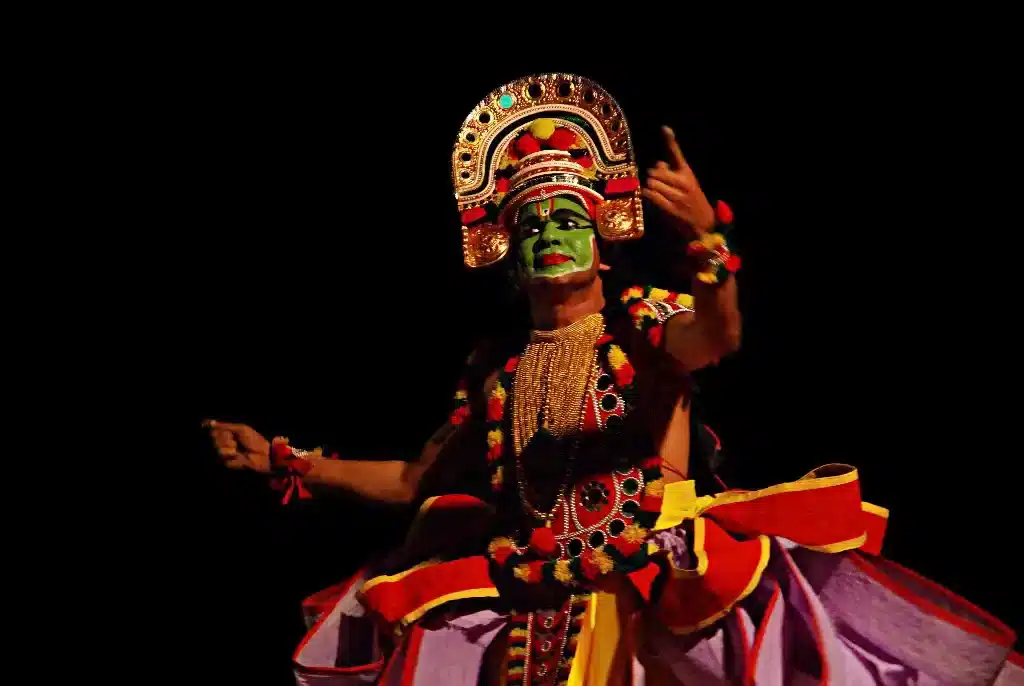
Ottamthullal dancer with exaggerated expressions
Origin and History:-
Ottamthullal originated as a kind of poetic storytelling that used humour and moral messages to engage listeners.
How to Perform:-
Storytelling is accomplished by performers through the employment of vibrant clothing, the exaggeration of face expressions, and rapid movement. The narrative is conveyed in rhythmic verses by a single performer, who is accompanied by a drummer and a cymbal player.
Fun fact:-
-
It is sometimes referred to as the "poor man's Kathakali" owing to the straightforward nature of the Ottamthullal.
7. Kalaripayattu:-
Kalaripayattu (in malayalam: കലരിപ്പയറ്റ്) is one of the oldest ways to fight in the world. It is often called the "mother of all martial arts." What makes it special is how it blends smooth dance moves with powerful fighting moves. It's not just a martial art; it's also a stunning performance art and a strong way to protect yourself.
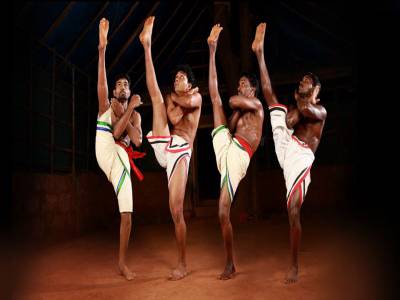
Kalaripayattu martial art performance
Origin and History:-
Kalaripayattu has roots that go back more than 3,000 years to Kerala's old shrines and battlefields. It was created by fighters to help them get better at fighting, be more agile, and concentrate better. After a while, it turned into a way to improve both physical and mental health. A lot of people think it was the start of other martial arts like Kung Fu.
How to Perform:-
Individuals who practice kalaripayattu move in a manner that is both precise and elegant, demonstrating their remarkable degree of strength and flexibility. While performing postures, leaps, and flips that give them the appearance of being animal-like athletes, they make use of conventional weaponry like as swords, shields, spears, and knives at the same time. Due to the fact that every move is well planned out and blends defensive maneuvers with graceful mobility, the art itself is both interesting and intense.
Fun fact:-
-
Kalaripayattu has had an impact on current yoga and fitness methods.
-
Its legacy even stretches to cinema, where its dramatic and graceful movements have inspired action choreography in international films.
8. Padayani:- The Vibrant Ritual Dance for Goddess Bhadrakali
Padayani (in malayalam: പടയണി), or "rows of soldiers," is a spiritual and traditional dance performance. This traditional performance is devoted to Goddess Bhadrakali, merging dramatic storytelling with vivid creativity. Padayani, with its massive, colorful masks and powerful enactments, is an intriguing expression of devotion and creativity.
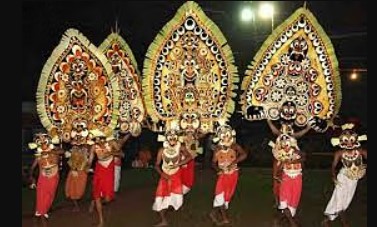
Padayani dancers with colorful masks
Origin and History:-
Padayani traces its roots to the Bhagavati temples of Kerala. It began as a ceremony to appease Goddess Bhadrakali and seek her celestial benefits. It expanded over time into a huge celebration of art and faith, bringing mythology and community together for a memorable experience.
How to Perform:-
Villagers wear colorful masks made from areca palm leaves. Every mask represents a celestial or legendary character. The dancers move rhythmically to the beats of traditional instruments like the chenda (a type of drum) and ilathalam (cymbals). Combining dramatic movements, music, and sacred rituals, the performance captivates both devotees and spectators.
Fun fact:-
-
Padayani celebrations typically extend several days, with each night containing unique stories and traditions.
-
This allows the community to completely embrace the holy festivity.
9. Oppana:- The Joyful Wedding Dance
Oppana (in malayalam: ഒപ്പന) is one of the most exciting and happy dances that are an essential part of the wedding functions among the Muslims of Kerala. This is a beautiful representation of happiness and union of two souls, which is why it makes the event even more colorful and special.
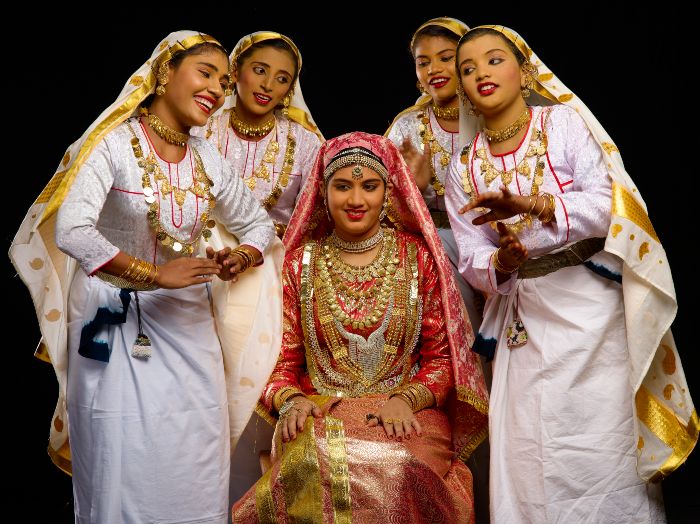
Women performing Oppana around bride
Origin and History:-
Oppana has its origin in the Malabar area of the present day Kerala and has been influenced by the Arabic culture. In due course it was adopted as a part of wedding and other festive celebrations where people got together to rejoice and celebrate.
How to Perform:-
In Oppana, a number of women, mainly the bride’s friends and relatives, gather and create a circle around the bride. They wear their best clothes, play tunes on small hand held instruments, sing happy tunes and move to the beat in a choreographed manner while the bride sits in the middle of it all, all dressed up for her big day. There is much mirth, music and the general atmosphere of joy which is a clear indication of the joy that the day brings.
Fun fact:-
-
The bride does not dance; she is the centre of attraction and is surrounded by her friends and family who are full of joy.
10. Margamkali:- The Spiritual Dance of Christian Heritage
Margamkali (in malayalam: മാർഗംകളി) is one of the most beautiful and widely practiced folk dances among the Syrian Christian community known of for Kerala its which ethereal is beauty. This ancient dance form is a part of rich Indian culture and embodies the teachings of Christ in the most beautiful manner while also depicting the culture of Kerala.
.jpg)
Margamkali dance during Christian celebrations
Origin and History:-
This dance Margamkali was performed during the early period of Christianity in Kerala; where the natives combined their culture with the European missionaries. Margam means path in Malayalam and it shows the path of Christ. Over the years this dance has become a part of the Christian festivals and celebrations which has helped in the preservation of the faith as well as the culture.
How to Perform:-
Margamkali is performed by 12 dancers, representing the 12 apostles of Christ. The dancers, clad in traditional white clothes, move smoothly in a circular arrangement around a lit oil lamp depicting Jesus. They sing lovely hymns in unison and narrate biblical stories with synchronised motions and passionate expressions, creating a tranquil and uplifting atmosphere.
Fun fact:-
-
People often do margamkali at Christian weddings and events, which brings people together to enjoy their faith and happiness.
Wrapping Up:-
People in Kerala dance their folk dances to celebrate life, culture, and faith. Every type of dance tells a story, whether it's about mythical heroes, divine wealth, or a happy wedding. Not just shows, Kathakali, Mohiniyattam, Theyyam, and Oppana are all very different types of dance. They keep Kerala's traditions alive, bring people together, and give an interesting look into the state's rich history.
The art, dedication, and joy in these dances make an impact on both locals and tourists that lasts a lifetime. Kerala's folk dances are like going into a living museum full of stories, music, and feelings. It's not a wonder that Kerala is still a cultural treasure that happily shows off its traditions to the world.
Frequently Asked Questions (FAQs):-
Q1: What is special about the folk dances of Kerala?
Ans: Kerala’s folk dances are deeply rooted in tradition and culture. They narrate stories from mythology, celebrate festivals, and strengthen community bonds. Each dance form has its unique style, costumes, and history.
Q2: How many folk dances are there in Kerala?
Ans: Kerala is home to almost 50 different folk and classical dance forms, showcasing its cultural diversity.
Q3: What is the difference between Kathakali and Mohiniyattam?
Ans: Kathakali is a dramatic dance-drama performed mostly by men with elaborate costumes and makeup, while Mohiniyattam is a graceful and feminine dance performed by women, emphasizing elegance and subtle expressions.
Q4: Why is Theyyam important in Kerala’s culture?
Ans: Theyyam is a divine ritual dance where the performer is believed to become a channel for deities. It plays a significant role in temple festivals and local spirituality.
Q5: Is Oppana only performed at weddings?
Ans: While Oppana is primarily performed at Muslim weddings, it is also showcased during other festive occasions in Kerala’s Malabar region.
Liked the above article? Kindly share it with your friends who have an interest in Folk-dance and Classical-Dance. Live in the high-spirited world of the dances of Kerala and celebrate its heritage in every rhythmic step!
Related Blogs
Types of Bharatanatyam: Learn what are the different types of bharatanatyam.
Bihu Dance: Experience the Bihu Dance: Honoring Assam's Energetic Heritage.
Types of Folk Dances: Discover the Range of Folk Dances Found in India.
Bhangra Dance: Uncover the history and style of Punjab’s Bhangra dance with our insightful article.
Folk Dance Forms Of Uttar Pradesh: Check out what are the folk dance forms of uttar pradesh.
Folk Dance Of Andhra Pradesh: Discover the lively and colorful folk dance forms that define the cultural landscape of Andhra Pradesh.
Frequently Asked Questions
Kerala’s folk dances are deeply rooted in tradition and culture. They narrate stories from mythology, celebrate festivals, and strengthen community bonds. Each dance form has its unique style, costumes, and history.
Kerala is home to almost 50 different folk and classical dance forms, showcasing its cultural diversity.
Kathakali is a dramatic dance-drama performed mostly by men with elaborate costumes and makeup, while Mohiniyattam is a graceful and feminine dance performed by women, emphasizing elegance and subtle expressions.
Theyyam is a divine ritual dance where the performer is believed to become a channel for deities. It plays a significant role in temple festivals and local spirituality.
While Oppana is primarily performed at Muslim weddings, it is also showcased during other festive occasions in Kerala’s Malabar region.
CBSE Schools In Popular Cities
- CBSE Schools in Bangalore
- CBSE Schools in Mumbai
- CBSE Schools in Pune
- CBSE Schools in Hyderabad
- CBSE Schools in Chennai
- CBSE Schools in Gurgaon
- CBSE Schools in Kolkata
- CBSE Schools in Indore
- CBSE Schools in Sonipat
- CBSE Schools in Delhi
- CBSE Schools in Rohtak
- CBSE Schools in Bhopal
- CBSE Schools in Aurangabad
- CBSE Schools in Jabalpur
- CBSE Schools in Jaipur
- CBSE Schools in Jodhpur
- CBSE Schools in Nagpur
- CBSE Schools in Ahmednagar
- CBSE School In Tumkur

Call Us to know more about Orchids
Swipe Up




.jpg&w=1920&q=80)












